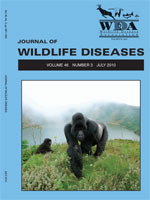A 3-day-old, male red deer (Cervus elaphus) with bilateral microphthalmia was found dead in the Western Alps in northern Italy. No other gross alterations were present. Ocular globes were formalin fixed and processed for histology. In both eyes, a large cyst, filled with keratin and lined by squamous epithelium admixed with sebaceous glands and hair follicles, expanded the anterior chamber. A mass composed of spindle cells and small tubules, embedded in myxoid ground substance, filled the vitreal chamber. No lens tissue was found, leading to the speculation that the dermoid cystic structures originated from abnormal differentiation of the primitive ectodermal lens vesicle. Immunohistochemistry with a panel of antibodies against cytoskeletal proteins revealed neural and mesenchymal elements within the vitreal mass. A complex bilateral ocular dysgenesis, with microphthal-mia, aphakia, and dermoid metaplasia of primitive lens vesicle was diagnosed. The latter finding was unusual and was previously documented only in Texel sheep (Ovis ammon), in which it was related to specific gene mutation on chromosome 23.
How to translate text using browser tools
1 July 2010
Bilateral Complex Microphthalmia with Intraocular Dermoid Cyst in a Neonate Red Deer (Cervus elaphus)
Daniela Gelmetti,
Irene Bertoletti,
Chiara Giudice
ACCESS THE FULL ARTICLE

Journal of Wildlife Diseases
Vol. 46 • No. 3
July 2010
Vol. 46 • No. 3
July 2010
eye
intraocular dermoid cyst
Lens
microphthalmia
red deer




